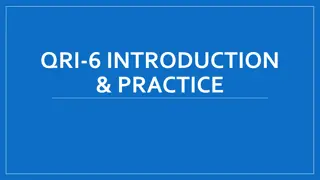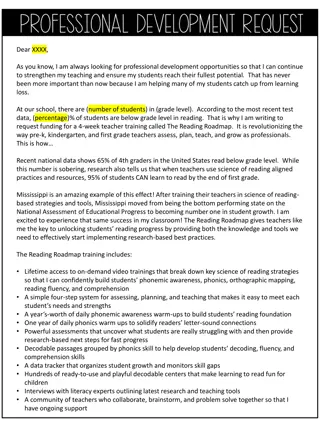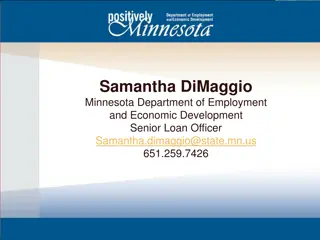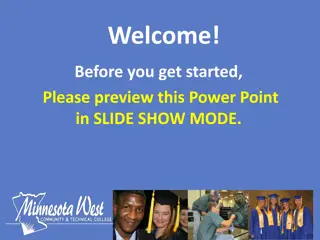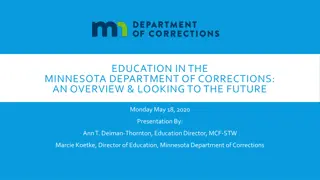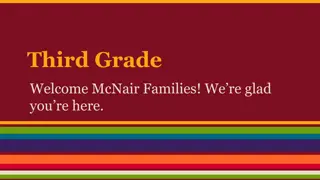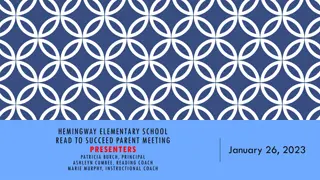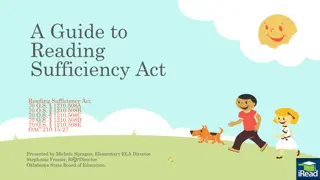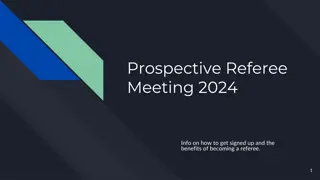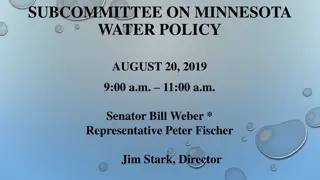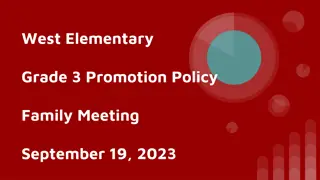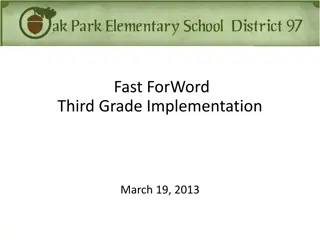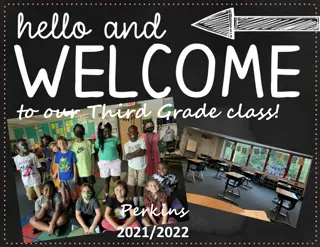Reading Well by Third Grade: Student Performance Trends in Minnesota
Explore the trends in student reading proficiency in Minnesota from 2012 to 2016, including statewide performance, performance by race/ethnicity, NAEP achievement levels, and 3rd-grade reading data. The data showcases the progress and challenges in achieving reading proficiency goals by third grade.
Download Presentation

Please find below an Image/Link to download the presentation.
The content on the website is provided AS IS for your information and personal use only. It may not be sold, licensed, or shared on other websites without obtaining consent from the author.If you encounter any issues during the download, it is possible that the publisher has removed the file from their server.
You are allowed to download the files provided on this website for personal or commercial use, subject to the condition that they are used lawfully. All files are the property of their respective owners.
The content on the website is provided AS IS for your information and personal use only. It may not be sold, licensed, or shared on other websites without obtaining consent from the author.
E N D
Presentation Transcript
Reading Well by Third Grade Presentation to the Minnesota Senate E-12 Finance Committee January 23, 2017
2012-2016 STUDENT PERFORMANCE TRENDS 2
Statewide Reading MCA trends All grades Reading proficiency, all tested grades: 2013: 57.6% 2014: 58.8% 2015: 59.5% 2016: 59.9% Projected proficiency for all: 2064 Minnesota Department of Education. (2016). 2012 2016 statewide reading proficiency, all grades. Minnesota Report Card. Retrieved from http://rc.education.state.mn.us/ 3
All Grades Disaggregated Reading Data by Race/Ethnicity Student Groups 2012-2016 MCA Reading Proficiency, All Grades by Student Group 90 80 70 60 Percent Profcient 50 40 30 20 10 0 White Asian/PI Am. Ind. Hispanic Black Proficiency Trends by Student Group 2012 2013 2014 2015 2016 Data from the Minnesota Report Card. Retrieved from http://rc.education.state.mn.us/ 4
2015 NAEP Reading Achievement Grade 4 Minn. / Nation Advanced: 9% Proficient: 30% Basic: 32% Below Basic: 29% 8% 27% 33% 32% Minnesota Department of Education. (2016). 2015 NAEP achievement levels, reading. Minnesota Report Card. Retrieved from http://rc.education.state.mn.us/ 5
2013-2016 MCA Reading Achievement Grade 3 2012*: 75.3% 2013*: 57.6% 2014: 2015: 2016: All tested grades 3rd grade 80.3% 57.4% 58.2% 58.9% 57.5% 58.8% 59.5% 59.9% *New standards in reading were implemented in 2013. Comparisons in reading from 2012 to 2013 should not be made. Minnesota Department of Education. (2016). 2015 NAEP achievement levels, reading. Minnesota Report Card. Retrieved from http://rc.education.state.mn.us/ 6
Disaggregated 3rd Grade Reading Data by Race/Ethnicity Student Groups 2012-2016 MCA Reading Proficiency, Grade 3 by Student Group 100 90 80 70 Percent Proficient 60 50 40 30 20 10 0 White Asian/PI Am. Ind. Hispanic Black Procifiency Trends by Student Group 2012 2013 2014 2015 2016 Data from the Minnesota Report Card. Retrieved from http://rc.education.state.mn.us/ 7
Disaggregated 3rd Grade Reading Data by Other Student Groups 2012-2016 MCA Reading Proficiency Grade 3 by Other Student Groups 80 70 60 Percent Proficient 50 40 30 20 10 0 FRP Sp. Ed. Migrant EL Homeless Proficiency Trends by Student Group 2012 2013 2014 2015 2016 Data from the Minnesota Report Card. Retrieved from http://rc.education.state.mn.us/ 8
2011-present KEY POLICIES 9
Read Well by Third Grade (RWBTG) 120B.12 2001: Passage of Reading Intervention law It has been titled Reading Proficiently No Later Than the End of Grade 3 since 2011, when the Local Literacy Plan was added. 10
Read Well Provisions Assessment and Identification Parent Notification and Engagement Interventions Staff Development Reporting 11
Literacy Incentive Aid 124D.98 (2011) A funding formula based on two measures: Proficiency Aid: Determined by the percentage of Grade 3 students meeting or exceeding the standards on the MCA-Reading Growth Aid: Determined by the percentage of Grade 4 students meeting their growth target from the 3rd grade MCA to the 4th grade MCA. FY 17 state total Literacy Incentive Aid is $45.6M Literacy Incentive Aid can be used for any purpose 12
Other Recent Literacy Initiatives Minnesota Reading Corps Funding to ServeMinnesota (124D.42) Singing-based Reading Program Pilot Funding to Rock n Read Statutory Definitions Comprehensive, scientifically based reading instruction (revised 2011) Dyslexia (added 2015) 13
What do we know about implementation of standards and policies? IMPLEMENTATION 14
Data Sources English Language Arts Standards (ELA) and Multi- Tiered System of Supports (MTSS) Implementation Survey Annually administered since 2014 Local Literacy Plan Analysis 2016 Sample analysis by Hanover Research Read Well Data and Plan Submission Online submission system in place since 2015 Several findings to share from this data. 15
2016 ELA/MTSS Implementation Survey Measures school-wide implementation of the core features of MTSS within the context of ELA 12 items embedded within the MTSS core features address standards work, specifically Only 19% of elementary schools, 13% of middle schools, and 9% of high schools rate a majority of those items as being at full implementation; Of those schools taking the survey both of the last two years, only 17% are at full implementation. 16
What is Full Implementation? Full implementation means that there is deep understanding and refined ongoing use of data and effective practices. Training and coaching are provided to prevent erosion and promote sustained implementation. 17
Challenges Slow progress; implementation takes time Back slide/sustainability Over 40% of key leaders changed between 2015 and 2016 (721 schools responded in 2016) Adoption of new standards, curriculum, or practices can impede implementation progress Districts and schools are often implementing multiple initiatives at once Continuous improvement processes often uncover the need to revisit work or false assumptions that need to be addressed 18
Full Implementation of Standards/MTSS Improves Reading Performance 2016 MDE data analysis shows a weak but positive correlation between MTSS responses and reading proficiency Schools that had an average fully implemented response on the MTSS survey had an average of 5% more students who scored proficient on reading than did the schools with an installing average response on the MTSS. 19
Local Literacy Plan Analysis Over 84% of districts plans met 50% or more of the required components of Read Well. However, only 24% of districts met 70% or more of the components. Districts are struggling to keep up with the changes in the law; there is a lag in implementation as capacity is built at all levels of the state system. 20
Read Well Data Submissions Reporting has revealed challenges with local assessment and data literacy. Assessments have been reported as measuring reading components that they do not assess. Multiple schools using the same assessment at the same grade report very different cut scores for grade level proficiency. Some assessments are being used for purposes that the publishers do not claim are valid (diagnostics or progress monitoring, for instance). Significant turn-over in staff reporting each year results in inconsistency and need for retraining. 21
Read Well Data Submissions (cont.) Districts are largely reporting students at- risk status, not their proficiency At-risk identification is needed to drive intervention, which is a critical focus of the law. However, as of 2011, the law asks districts to identify if students are reading at grade level. Therefore, there is a question as to whether districts are assessing proficiency or only identifying students not at-risk. 22
MDE EFFORTS 23
Current MDE Efforts Minnesota Standards Portal development Tiered Fidelity Inventory pilot project Regional Centers of Excellence reading specialists providing adaptive assistance Standards-based Education Rubric development for Priority/Focus Schools Learning Management System pilot E-Learning module and course development 24
Current MDE Efforts (cont.) Development of the Kindergarten Entry Profile (KEP), which includes a valid and reliable menu of comprehensive assessments that can be used for PreK- 3rd Grade Early Learning Assessment Tool Finder available on MDE website Early Childhood Indicators of Progress revised and posted January 2017 Regional certified trainers available to provide support for KEP administration Publication: Navigating the School System When a Child is Struggling with Reading or Dyslexia: Frequently Asked Questions 25
Current MDE Efforts (concluded) Professional Development and Technical Assistance Age 3 to Grade 3 literacy and MTSS Communities of Practice Professional development collaborations with Minnesota organizations: Minnesota Writing Project, Minnesota Reading Association, Minnesota s Reading and Writing Centers (U of M), Higher Education Literacy Partnership (dyslexia organizations), and Minnesota ASCD ESSA Literacy Education for All Results for the Nation (LEARN) Grant application 26
Presenter Contact Information Beth Aune, Ph.D. Director, Division of Academic Standards and Instructional Effectiveness Beth.aune@state.mn.us Cory Stai, M.Ed. Reading Specialist Cory.stai@state.mn.us 27





